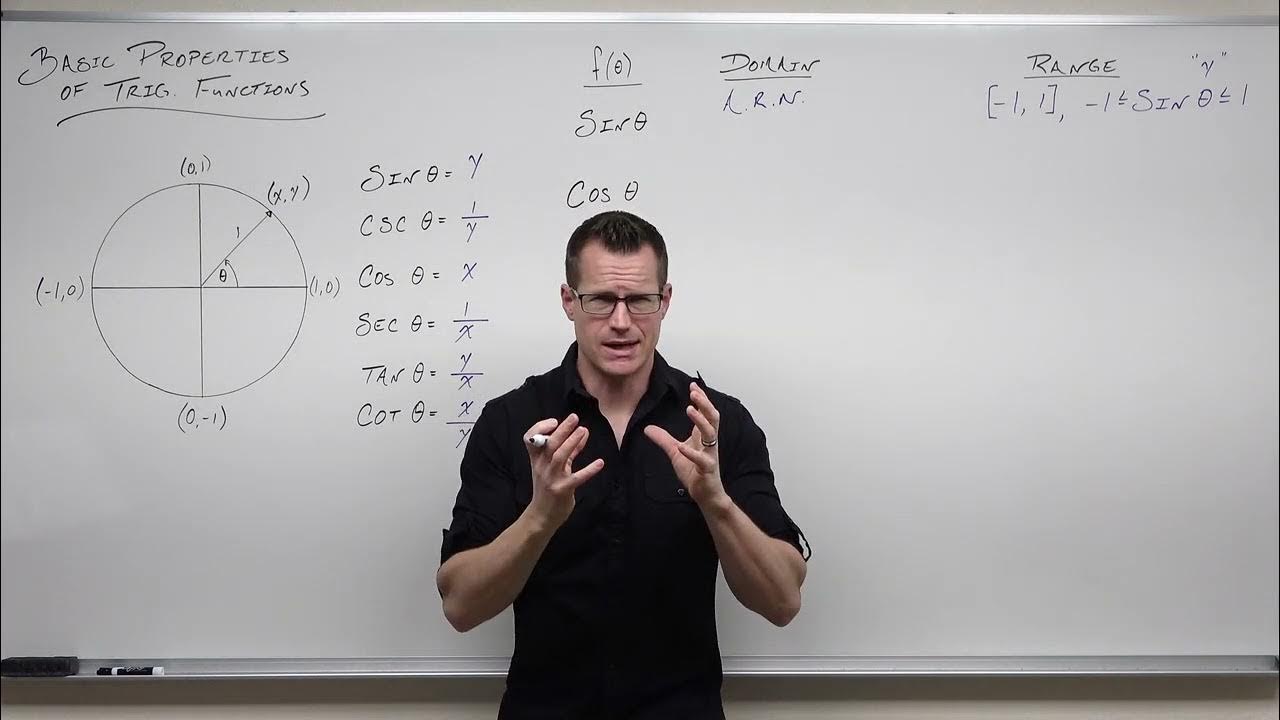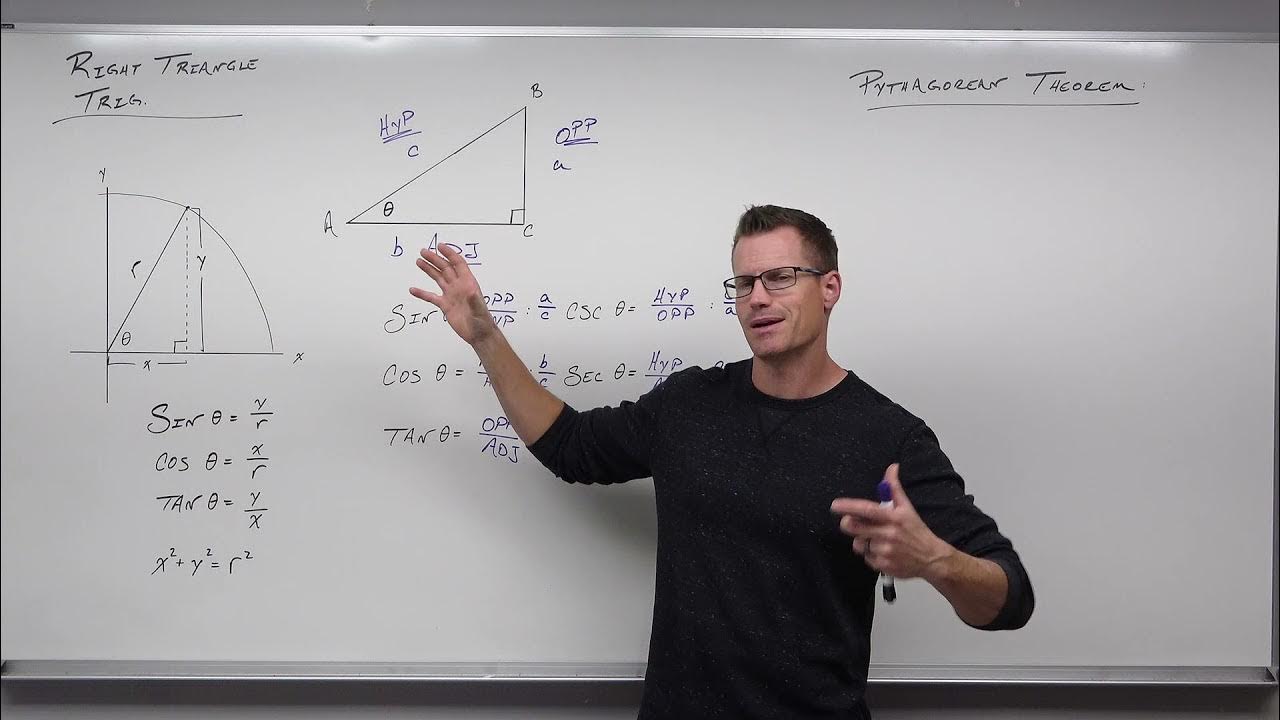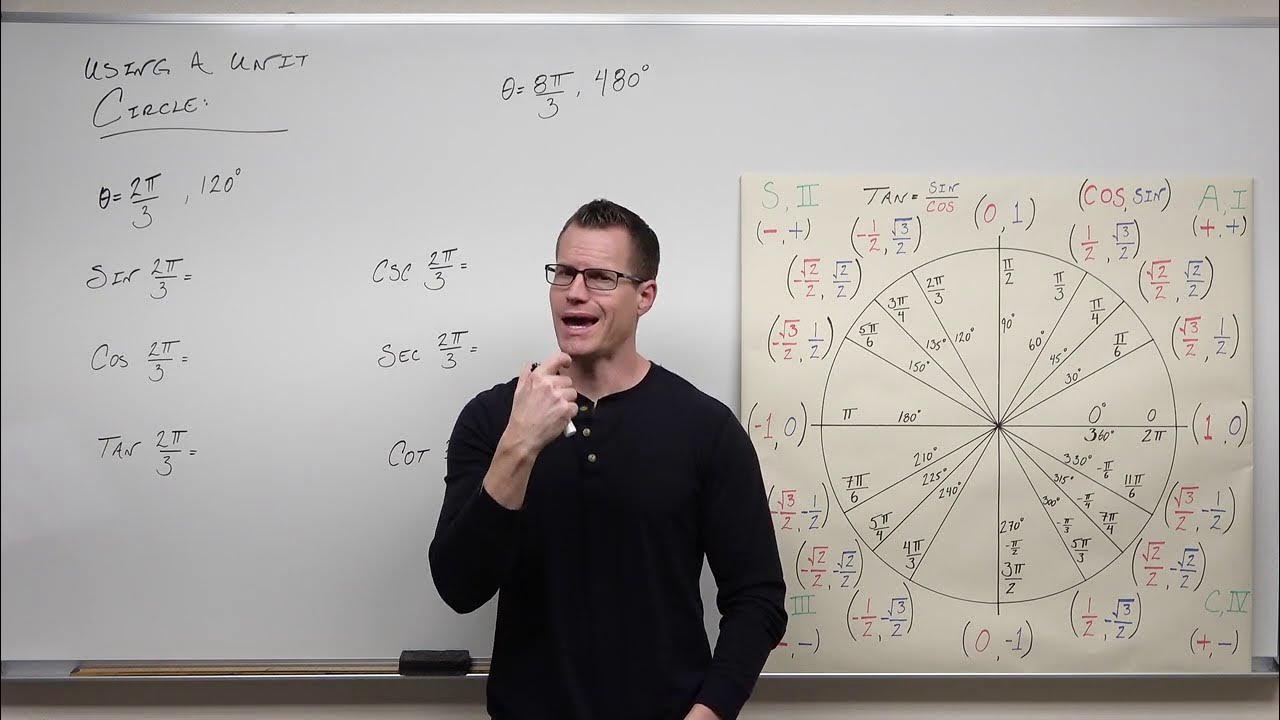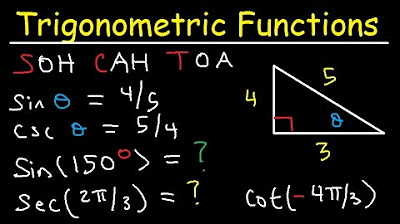Calculus 1 Lecture 0.3: Review of Trigonometry and Graphing Trigonometric Functions
TLDRThis comprehensive transcript delves into the fundamentals of trigonometry, focusing on angles, the unit circle, and the interplay between trigonometric functions and their graphical representations. The speaker begins by explaining the concept of angles in relation to the x-axis, introducing the terms 'initial side' and 'terminal side,' and distinguishing between positive (counterclockwise) and negative (clockwise) angle measurements. A detailed exploration of radians and degrees follows, highlighting the mathematical relationship between the two, with a clear explanation of how to convert between them. The importance of the number pi in this context is emphasized, given its role in the circumference to diameter ratio of a circle. The discussion then transitions to graphing, with the speaker demonstrating how to plot angles on a unit circle and explaining the concept of coterminal angles—angles that share the same terminal side despite having different measures. Trigonometric functions are introduced, with sine, cosine, and tangent being defined in relation to the sides of a right triangle. The speaker also touches on the reciprocal trigonometric functions—cosecant, secant, and cotangent—and their relationships to the primary functions. A significant portion of the transcript is dedicated to the graphical representation of trigonometric functions, particularly the sine and cosine functions. The effects of various coefficients on these functions' amplitude and period are discussed, and the process of graphing functions of the form y = a * sin(Bx) or y = a * cos(Bx) is outlined. The speaker also explains how to apply vertical and horizontal shifts to these graphs, providing algebraic techniques for determining the direction and magnitude of these shifts. Throughout the transcript, the speaker emphasizes the practical applications of trigonometry, such as calculating the dimensions of triangles and the coordinates of points on a unit circle. The importance of memorizing key values and mastering trigonometric identities is also stressed, as these skills are essential for solving more complex problems in the field. The summary concludes with a reminder for students to review their trigonometric identities, ensuring they are well-prepared for further studies in calculus and other advanced mathematics courses.
Takeaways
- 📐 **Understanding Angles**: Angles are typically measured with respect to the x-axis and can be positive (counterclockwise) or negative (clockwise).
- 🔢 **Radians vs. Degrees**: Radians are related to the number π and are used to measure angles. They are connected to degrees by the equation 2π radians = 360 degrees.
- ⏩ **Conversion Between Radians and Degrees**: To convert between radians and degrees, use the relationships 1 radian = 180/π degrees and 1 degree = π/180 radians.
- 📉 **Graphing Angles**: When graphing angles, it's important to understand the unit circle and how angles relate to the x and y coordinates on the circle.
- 📈 **Trigonometric Functions**: The basic trigonometric functions (sine, cosine, tangent) are ratios of the sides of a right triangle and can be defined in terms of coordinates on the unit circle.
- 🔴 **Reciprocal Trigonometric Functions**: The reciprocal functions (cosecant, secant, cotangent) are simply the reciprocals of the basic trigonometric functions.
- 🤔 **Memorizing Common Angles**: It's beneficial to memorize common angles and their corresponding trigonometric function values for quick reference.
- 🧮 **Quadrants and Sign of Trigonometric Functions**: Knowing the signs of the trigonometric functions in different quadrants is crucial for determining the function's value for any angle.
- 🔍 **Reference Angles**: Reference angles are used to find the trigonometric function of any angle by first finding the acute angle formed with the x-axis.
- 📌 **Graphing Trigonometric Functions**: The amplitude and period of a trigonometric function can be adjusted by modifying the coefficients (a and b) in the function's equation.
- 🔄 **Shifting Trigonometric Graphs**: The position of the graph on the coordinate plane can be shifted horizontally by adding or subtracting a value from the x variable within the function.
Q & A
What is the primary focus of the discussion in the transcript?
-The primary focus of the discussion is on trigonometry, covering topics such as angles, reference angles, graphing of trigonometric functions, and the concept of converting between degrees and radians.
What is the relationship between radians and degrees?
-Radians and degrees are two different units for measuring angles. They are connected by the equation 2π radians equals 360 degrees. This relationship allows for conversion between the two units.
How can you find the trigonometric functions of any angle using a unit circle?
-By determining the angle's reference angle and knowing the quadrant in which the angle lies, you can use the properties of the unit circle to find the sine, cosine, and tangent of the angle. The unit circle provides the coordinates (x, y) for any angle, where x corresponds to the cosine and y corresponds to the sine of the angle.
What is the significance of the number π in trigonometry?
-The number π (pi) is an irrational number that represents the ratio of a circle's circumference to its diameter. It is significant in trigonometry because it is used in the relationship between radians and degrees and appears in various trigonometric identities and equations.
How do you convert 200 degrees into radians?
-To convert 200 degrees into radians, you multiply the degree measure by π/180. So, 200 degrees in radians is equal to (200 * π) / 180, which simplifies to (10π) / 9 radians.
What is a reference angle and how is it used to find the trigonometric functions of an angle?
-A reference angle is the acute angle that a given angle makes with the x-axis. It is used to find the trigonometric functions of an angle by first determining the reference angle and then using the angle's quadrant to determine the signs of the trigonometric functions. The reference angle allows you to find the sine, cosine, and tangent of the angle using the properties of the unit circle.
What are the key components of a trigonometric function of the form y = A sin(Bx) or y = A cos(Bx)?
-The key components are A, which represents the amplitude and determines how high or low the graph oscillates from the x-axis, and B, which determines the period of the function, or how often the function repeats its values.
How does the amplitude of a trigonometric function affect its graph?
-The amplitude affects how high or low the graph of a trigonometric function oscillates from the x-axis. If the amplitude is positive, the graph will oscillate between the amplitude value above and below the x-axis. The absolute value of A determines the amplitude.
What is the period of a trigonometric function, and how is it calculated?
-The period of a trigonometric function is the length of one complete cycle of the function before it repeats. It is calculated using the formula (2π) / B, where B is the coefficient of x in the function (e.g., in y = A sin(Bx) or y = A cos(Bx)).
How do you determine the direction of the shift of a trigonometric function along the x-axis?
-The direction of the shift along the x-axis is determined by the sign of the constant C in the function's argument (Bx + C). If C is positive, the function shifts to the left, and if C is negative, it shifts to the right.
What are the basic trigonometric identities that one should be familiar with?
-Some basic trigonometric identities include the Pythagorean identity (sin²θ + cos²θ = 1), the tangent identity (tanθ = sinθ / cosθ), and the double-angle and half-angle formulas. These identities are essential for simplifying and evaluating trigonometric expressions.
Outlines
📚 Introduction to Trigonometry and Angles
The video begins with an introduction to trigonometry, focusing on the basics of angles in relation to the x-axis. It explains the concept of reference angles and how they are used to find trigonometric functions of any angle. The importance of understanding angles in terms of degrees and radians is emphasized, including the mathematical relationship between them, which is that 2π radians equal 360 degrees. The video also touches on the idea of positive and negative angles, with counterclockwise rotation corresponding to positive angles and clockwise rotation to negative angles.
🔢 Converting Between Radians and Degrees
This paragraph delves into the conversion between radians and degrees. It provides the formula for conversion and explains how to apply it in both directions. The process of converting 200 degrees to radians and vice versa for negative 3π/4 radians is demonstrated. The video also discusses the concept of coterminal angles, which are angles that share the same terminal side after rotating in different directions for a full circle.
📈 Graphing Trigonometric Functions
The speaker introduces graphing of trigonometric functions, explaining how to plot angles on a unit circle. It describes the process of breaking down the circle into sections represented by π and how to locate the position of an angle on the circle. The concept of acute angles and how they are used in graphing is also covered, along with a brief mention of the movie 'The Terminal' as a humorous aside.
🔁 Understanding Trigonometric Functions and the Unit Circle
The paragraph discusses the relationship between the sides of a right triangle and the angles of a unit circle. It defines trigonometric functions such as sine, cosine, and tangent in terms of the ratios of the sides of a right triangle. The video also explains the concept of reciprocal trigonometric functions, like secant, cosecant, and cotangent, and their relationship to the primary trigonometric functions.
🤔 Trigonometric Functions and the Coordinate System
This section explores how the trigonometric functions sine, cosine, and tangent can be computed using the coordinates of a point on the unit circle. It explains that the y-coordinate of a point corresponds to the sine of the angle, and the x-coordinate corresponds to the cosine. The paragraph also covers the relationship between tangent and the ratio of sine to cosine, as well as the identities involving these functions.
🧮 Memorizing Trigonometric Values and Quadrants
The speaker emphasizes the importance of memorizing common trigonometric values for specific angles and understanding the behavior of sine, cosine, and tangent across different quadrants. It also mentions the need to be familiar with the signs of these functions in each quadrant, which is crucial for determining the values of trigonometric functions for any given angle using reference angles.
📐 Reference Angles and Their Applications
The paragraph explains the concept of reference angles and how they are used to find the trigonometric function values for any angle. It describes the process of finding reference angles in different quadrants and how the quadrant location affects the sign of the trigonometric function values. The video provides an example of finding the sine, cosine, and tangent for 5π/3 using the reference angle and the quadrant information.
📉 Graphing Trigonometric Functions with Amplitude and Period
This section focuses on graphing trigonometric functions, specifically the sine function, and how the amplitude and period of the function affect its graph. It explains that the amplitude is the absolute value of the coefficient 'a' in front of the function, which determines how high and low the graph goes from the x-axis. The period is given by 2π divided by the coefficient 'B', which determines how often the function repeats. The video also discusses how to identify and graph the function's key points, such as peaks and valleys.
🔄 Understanding and Graphing Shifts in Trigonometric Functions
The speaker introduces the concept of shifting trigonometric functions along the x-axis. It explains that the shift is determined by the value of 'C' in the function and whether it is added or subtracted from 'BX'. The paragraph clarifies that adding 'C/B' results in a left shift, while subtracting it results in a right shift. The video also covers how to apply these shifts to the graph of a trigonometric function to determine its final position.
🔍 Reviewing Trigonometric Identities and Formulas
The final paragraph stresses the importance of reviewing trigonometric identities and formulas. It mentions that understanding basic identities like tangent being sine over cosine, the Pythagorean identity, and double and half-angle formulas is essential for working with integrals and derivatives of trigonometric functions. The video encourages students to familiarize themselves with these concepts to prepare for more advanced mathematical topics.
Mindmap
Keywords
💡Trigonometry
💡Unit Circle
💡Reference Angle
💡Radians and Degrees
💡Trigonometric Functions
💡Amplitude
💡Period
💡Graphing
💡Quadrants
💡Translations
💡Trigonometric Identities
Highlights
Introduction to trigonometry basics using angles and reference angles to find trigonometric functions.
Explanation of graphing trigonometric functions and understanding why they take the shape they do.
Differentiation between degrees and radians, and the mathematical relationship between them.
Conversion methods from degrees to radians and vice versa using the equation 2π radians = 360 degrees.
The concept of coterminal angles and how they can represent the same angle despite being measured differently.
Techniques for graphing angles on a unit circle by breaking up each section of π into equal parts.
Understanding the relationship between the sides of a right triangle and the unit circle to compute trigonometric functions.
Definition and use of trigonometric functions such as sine, cosine, and tangent in relation to angles and their respective sides.
The importance of associating trigonometric functions with an angle and the common mistake of omitting this association.
Overview of reciprocal trigonometric functions like cosecant, secant, and cotangent in relation to the primary functions.
The significance of the unit circle in determining the values of sine and cosine for any angle.
Using the ASTC (All Students Take Calculus) mnemonic to remember the signs of trigonometric functions in different quadrants.
Combining reference angles with quadrant information to determine the value of any trigonometric function.
The process of graphing more complex trigonometric functions, such as y = a * sin(Bx), and understanding the impact of coefficients 'a' and 'B'.
How the coefficient 'a' affects the amplitude of the trigonometric function and 'B' affects its period.
The concept of graphing translations of trigonometric functions and determining the direction and magnitude of the shift.
Practical tips for sketching the graph of a trigonometric function by first addressing amplitude, period, and then applying the shift.
Importance of reviewing and understanding basic trigonometric identities and formulas for advanced mathematical applications.
Transcripts
Browse More Related Video

Basic Properties of Trigonometric Functions (Precalculus - Trigonometry 8)

Introduction to Right Triangle Trigonometry (Precalculus - Trigonometry 30)

Trigonometric Functions and the Unit Circle (Precalculus - Trigonometry 6)

How to Use the Unit Circle in Trigonometry (Precalculus - Trigonometry 7)

Trigonometry: Unit Circle

Trigonometric Functions of Any Angle - Unit Circle, Radians, Degrees, Coterminal & Reference Angles
5.0 / 5 (0 votes)
Thanks for rating: